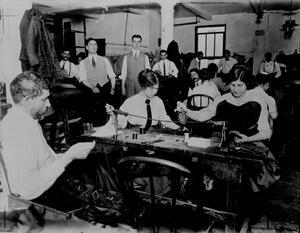Collective Action: Lessons from the Labor Movement
What is the meaning of work? What conditions cause workers to suffer and what inspires them to take action to improve their lives? What can Jewish history teach us about contemporary labor issues and our responsibility towards workers around the world? This online learning program models how to investigate historical photographs and memoirs. You will hear several stories about American Jewish labor history and explore connections to contemporary labor issues.
Session Recording
Watch the recording to learn more about the Labor Movement & collective action and to watch modeled document studies.
Session Materials
- PowerPoint Presentation
- Chat Log
- “Fact Feeling Idea Question” Lino Board—generated by session participants
Documents and Primary Sources
- Photographic Impressions Document Study
- Excerpts from Pauline Newman's unpublished memoir about working conditions
- Excerpts from Pauline Newman's unpublished memoir about the 1909 garment worker's strike (known as the “Uprising of the 20,000”
- “I Was a Warehouse Wage Slave” blog post by Mac McLelland
- “Inside Amazon's Warehouse”, a photo study
Related Resources from the Jewish Women’s Archive
- Lesson Plan: From Suffering to Action, From the Individual to the Collective from Living the Legacy
- Lesson Plans for youth, family, and adults: “We Have Found You Wanting”: Labor Activism and Communal Responsibility in Go & Learn
- The Triangle Shirtwaist Fire in Jewish Women: A Comprehensive Historical Encyclopedia
- Triangle Factory Fire Commemoration
- “Why history is not just about the past”, a Jewish Women, Amplified blog post by Judith Rosenbaum
From the Field
Previous winners of the Natalia Twersky Educator Award have included primary sources from Jewish women in the Labor Movement in the lesson plans they created.
- Allyson Mattanah's “Who will you be? Esthers and Vashtis in the Labor Movement”
- Judith Sandman's “What Will It Cost Me to Work for You?”
Collective Action and the Labor Movement elsewhere on the web
- Lesson Plans and Educational Resources from The Lower East Side Tenement Museum
- Teacher Resources featured in Living the Legacy
Jewish Texts and Jewish Values
At the end of the program, San Francisco-based educator Marilyn Heiss raised the following point: “I think my students would not see this as a Jewish issue, as opposed as to an issue for all.” This is an ongoing conversation in many of our professional development programs: Is social justice really a Jewish issue? Why or why not? Is it important for students to learn about social justice through a Jewish lens? Why or why not? How can we teach about social justice in a way that is both Jewish and relevant to our students?
Another participant, Rabbi Michael Rothbaum, shared two Jewish texts that may help you explore these issues through a Jewish lens.
- Babylonian Talmud, Tractate Eruvin 65b: Rabbi Ilai says, “A person makes their character known in three ways: how they drink (“koso”), how they spend (“kiso”), and how they express anger (“ka'aso”)." (Hebrew text and translation can be found on On1foot.org.)
- “A man may stumble over his brother” (Leviticus 26:37) One may come to sin because of his brother, teaching that all of us [Jews?] are responsible for each other. [The Talmud answers:] There [Torah] is referring to one who had the power to protest, and did not protest.”—Sanhedrin 27b (Courtesy of Rabbi Michael Rothbaum)
Please add your thoughts/comments below or join the conversation on JWA's National Educators' Network.



